We are impatient people living in an age of instant gratification. So rather than bettering ourselves lets just dive in head first and demand that our targets give instant feedback. Steel targets are more fun than paper, let me tell you why.
Why Should you shoot Steel Targets?
Because paper gets old, and variety is the spice of life! Paper is great for zeroing in and making fine adjustments. It’s also great during competition when you need to differentiate between A, C, D zones…etc. But imagine a world where you never have to tape up targets again. You either hit it or you don’t, it’s that simple. You just select the target size you want, shoot it as much as you want, and only go down range when your done shooting. Or when you want to test your spay painting skills.
Steel targets, quality ones anyway, are made out of something called AR500 steel. They’re actually surprisingly affordable, and could save you money in the long run if you’re a high-volume shooter. The real savings comes in the form of time. Shooting is an expensive hobby, and I don’t go to the range to save money. I go to improve and relax. Anything that gives me more time to do that is awesome. If you’re curious about steel targets this guide should tell you everything you need to know about getting started with some steel targets of your very own.
AR500 Steel
Abrasion resistant 500 (AR500) is a through-hardened steel that is high in carbon, and has a certified Brinell hardness of 500, hence the name. There are AR300 steels that aren’t really used in anything but low-velocity rimfire targets, and there are higher hardness steels like AR700 that are actually too hard to be safely used. AR550 is a more common steel that is used in many rifle targets as it is a little more impact resistant, but also more expensive. In general, AR500 targets will be thicker and thus heavier than AR550 targets rated for the same impact.
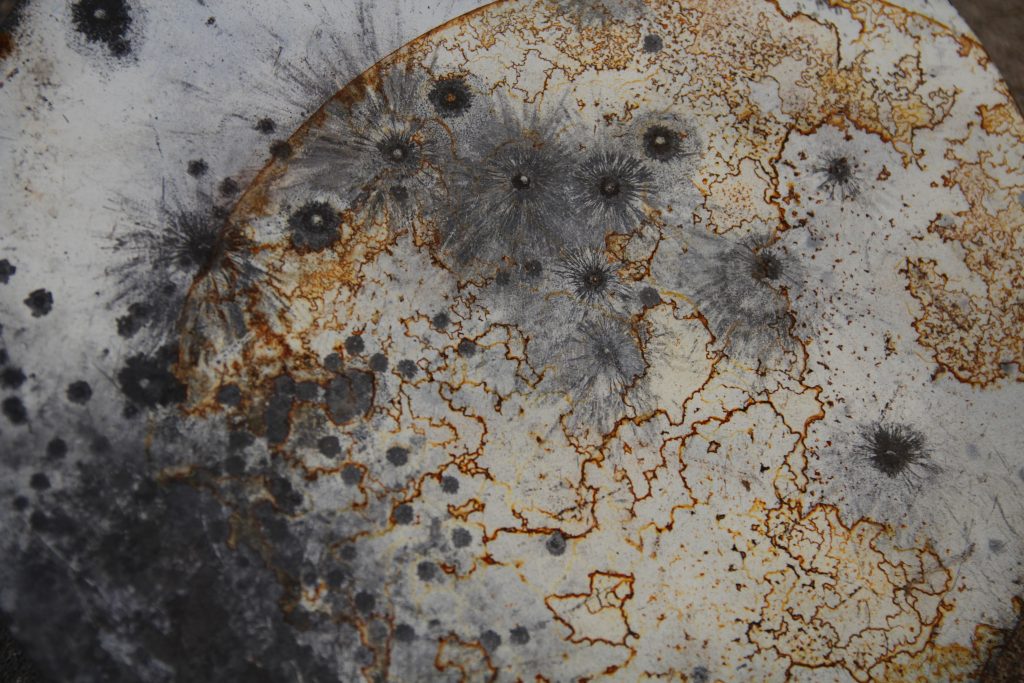
Impacts from 55gr Hornady FMJs, and some #8s from a 12 gauge
You also don’t want to use anything that isn’t hardened as almost all centerfire rifle rounds, and even many pistol and shotgun rounds will severely deform, or even punch straight through mild steel.
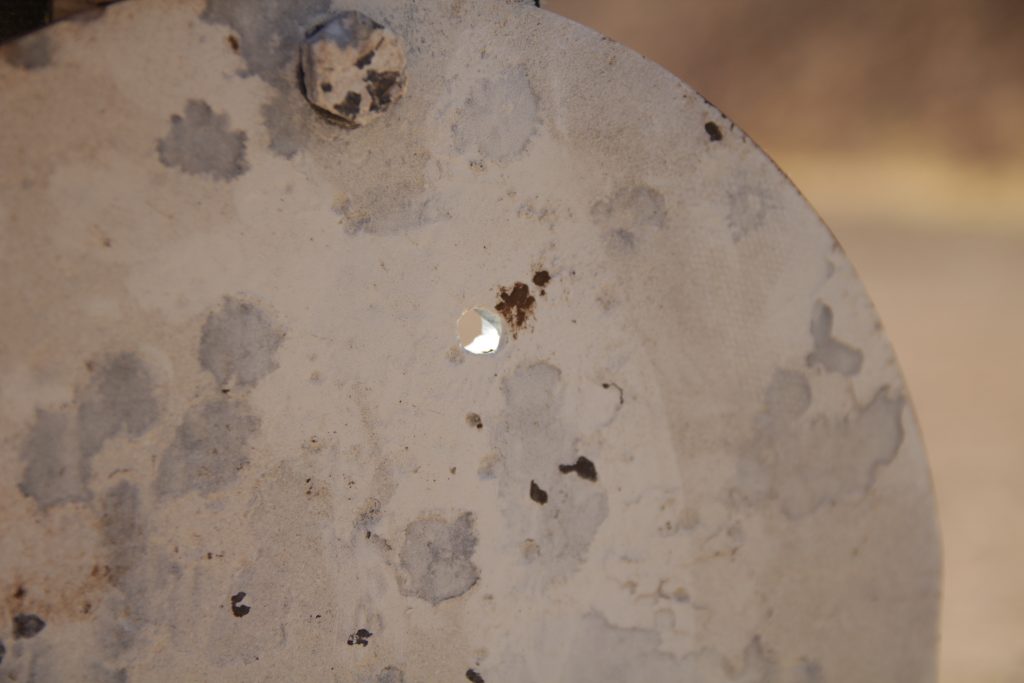
3/8″ AR500 drilled straight through by a 130 Nosler Partition from a .270 Wby Mag, My bad…
The Brinell hardness standard for steel targets and impact plates used steel plate body armor is 500. This is more or less the sweet spot for combining hardness and a resistance to impact that will allow the target to sustain multiple bullet impacts without deforming or cracking.
Brinell hardness is an indentation rating given to a material that has been tested by pressing a steel or carbine ball into the surface and measuring the size of the dent that is left. The goal is for the steel used in these targets to dent, rather than crack or crater. If it cracks it generally too hard, and if it craters or punches straight through it is too soft. To give you a rough idea of the scale:
- Lead 5HB
- Mild Steel 120 HB
- AR500 (500 HB, duh)
- Glass 1550 HB
This is important for the obvious reason that it protects your investment and lets you get several years of use out of that nice new steel gong you hung up at the range, but it is also important because it protects you.
A pitted or worn steel target can cause unpredictable splatter (bullet fragmentation) or spalling (target fragmentation) that can create a ricochet that could be dangerous to the user. This dramatically decreases the safety zone around a target, and can mean that instead of shooting as close as 10 yards, you have to move back to 50 yards, or farther.
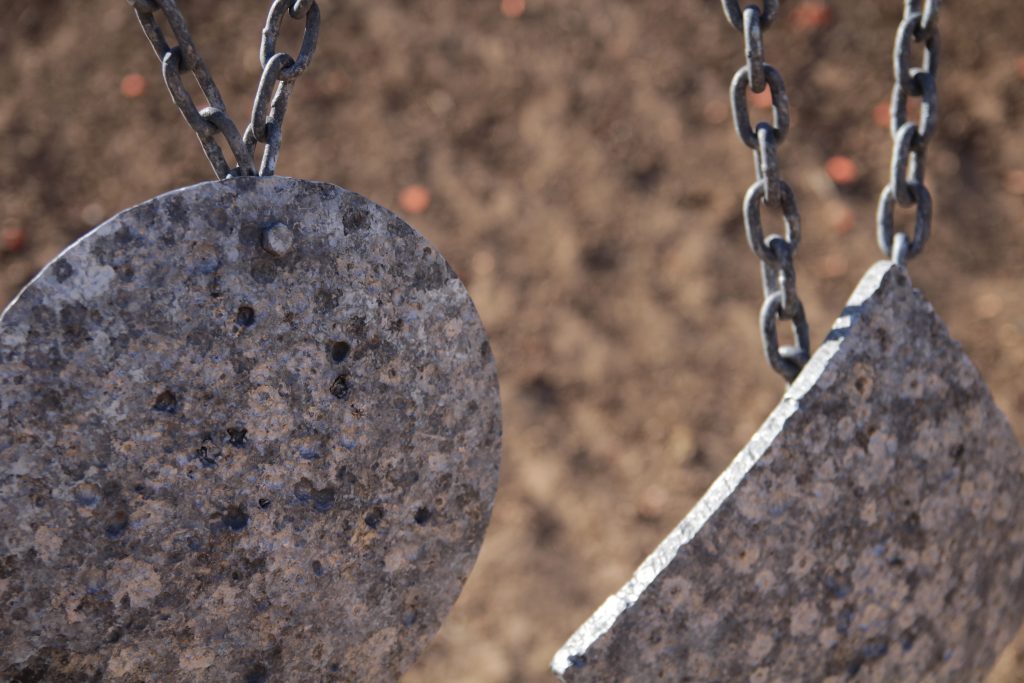
Severely pitted and cratered steel, time to retire
You also don’t want to shoot at scrap steel, or any other non-uniform hard surface as anything at an incorrect angle can easily send a bullet, or at least large pieces of it, back towards you at speeds fast enough to injure or kill.
A sufficiently hard steel like AR500, when angled properly and hung at the appropriate angle, will develop micro-indentations after hundreds of repeated impacts, but this compression actually makes the target even harder. They’ll eventually become brittle due to the sheer force of repeated impacts, but you’ll more than get your money’s worth by then (and will have shot thousands of bullets at it).
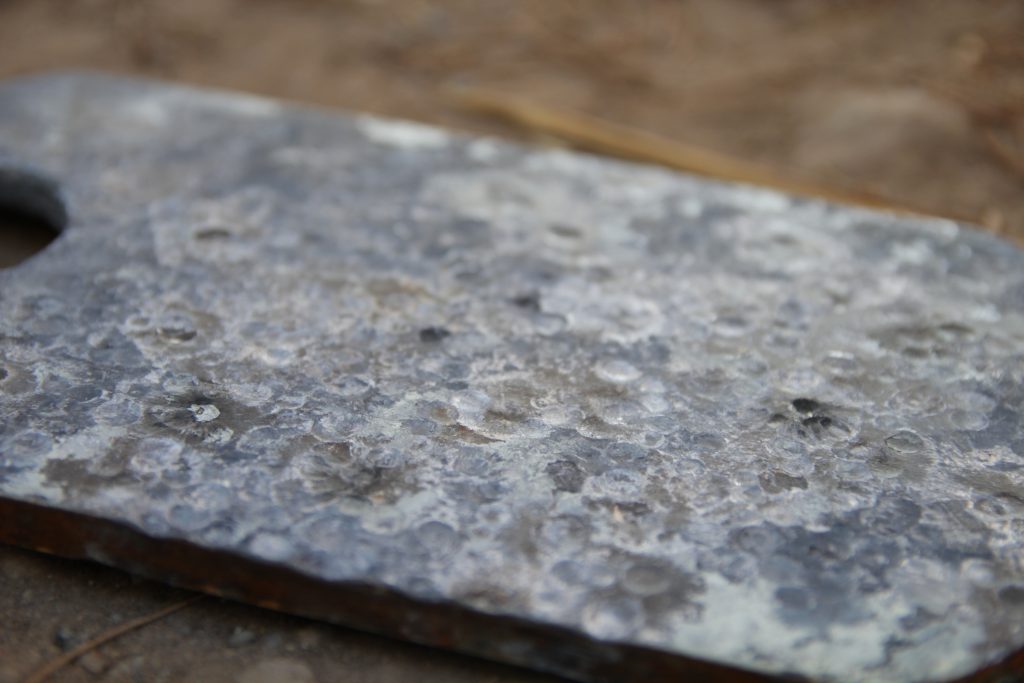
Standard pitting, you can expect this after a few thousand rounds
You’ll want to avoid steel-core round like M855 or “green-tip” 5.56 as well as solid copper projectiles as these harder metals can damage even hardened steel and make shooting at the target unsafe.
Instead, stick to lead or jacketed rounds, or even better frangible metal powder rounds that turn into dust on impact with a hard surface. These rounds allow you to safely get much closer to steel targets, even up to point-blank range, without issue (still check with your target and ammo manufacturer, and follow all safety and target-care instructions, however).
Pistol Targets
There are huge number of AR500 pistol targets out there and it’s important to choose your targets carefully, not just to maximize your investment, but also to be safe.
For most pistol rounds up to .45 ACP, ¼” thick targets will suffice, and ⅜” will cover everything else up to S&W 500. In general, you’ll want to stay at least ten yards back from your target at all times unless using frangible ammunition.
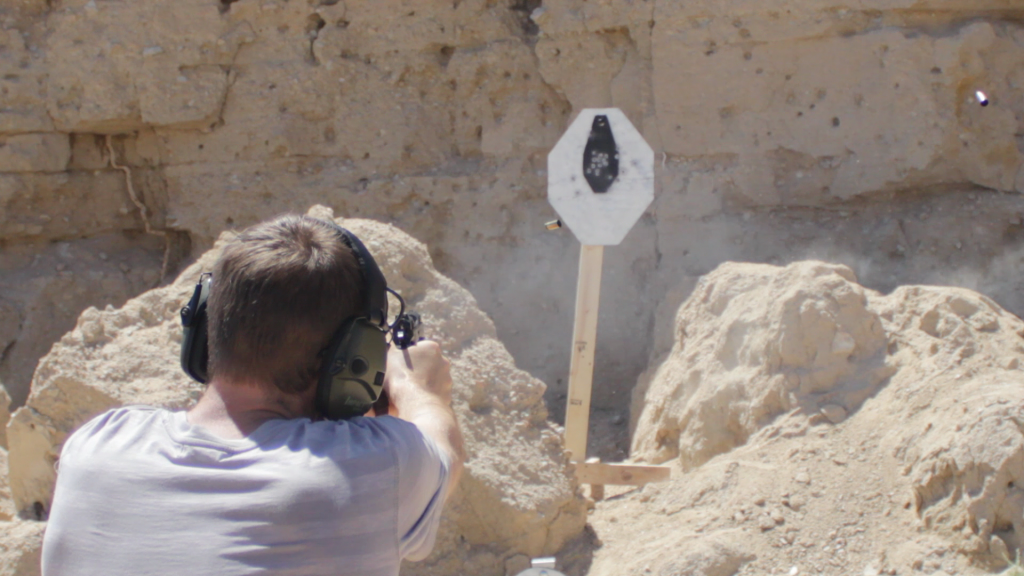
Full size Classic IPSC
In this thickness range, you will find a huge variety of steel targets, from plate racks that have multiple 6-10” plates for you to knock down, to simple gongs, to silhouettes of everything from cowboys to zombies and all manner of animals.
If you do any kind of competition shooting with a pistol, you are almost guaranteed to see steel targets. Especially in action shooting sports like Steel Challenge (duh), USPSA, and 3Gun. This is a big part of why steel-core and all-copper bullets are banned at most shooting sports events, as they can damage steel targets and throw sparks like the 4th of July (which means you shouldn’t be using them at your home range either).
For home use, there are a number of portable steel targets and stands designed for pistols that you can take out to private land, shoot at to your heart’s content, and then load back up and take away. Those who are so inclined can also setup permanent home ranges with a variety of targets.
In particular, IDPA silhouettes and other defensively-minded shapes are a good way to train to defend yourself, but you can also get everything from small spinner targets (great for training timing and trigger control) to giant gongs suitable for plinking at the extremes of pistol range.
Rifle Targets
Rifle targets require a little more planning and thoughtful setup, but it’s really simple to get things going if you want. If you want to get a feel for them just go to any 3Gun or Precision Rifle competition.
This can give you an idea if steel rifle targets are something you want to invest in.
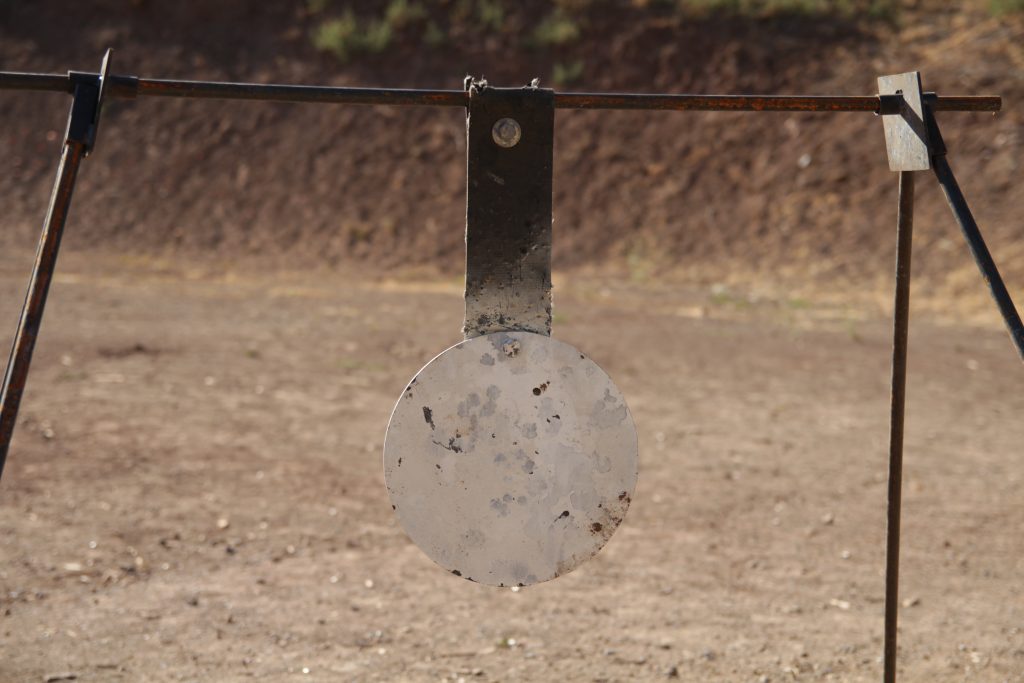
12″ gong hung from a fiber enforced rubber strap
There are just as many types and varieties of AR500 rifle targets as there are pistol targets. You’ll see a lot more silhouettes and gongs than plate racks and dueling tree style targets. Almost any shape can and has been laser cut, or water jetted. If you want it, it’s either out there, or you can custom order it.
This is mostly because rifle targets are going to be further away, usually at least 100 yards, for safety (both for you, and the target) so you’ll see bigger targets to make hits more reasonable.
If you want your own rifle targets, you’ll need to choose something rated for high-velocity rifle rounds, which should always be at least 3/8ths of an inch thick for non-magnum rifle rounds. Anything bigger than .308, you’ll want a ½” or ⅝” inch target plate.
To ensure your target will handle whatever you’ll be throwing at it, calculate the energy of the round, and compare that to the following standards.
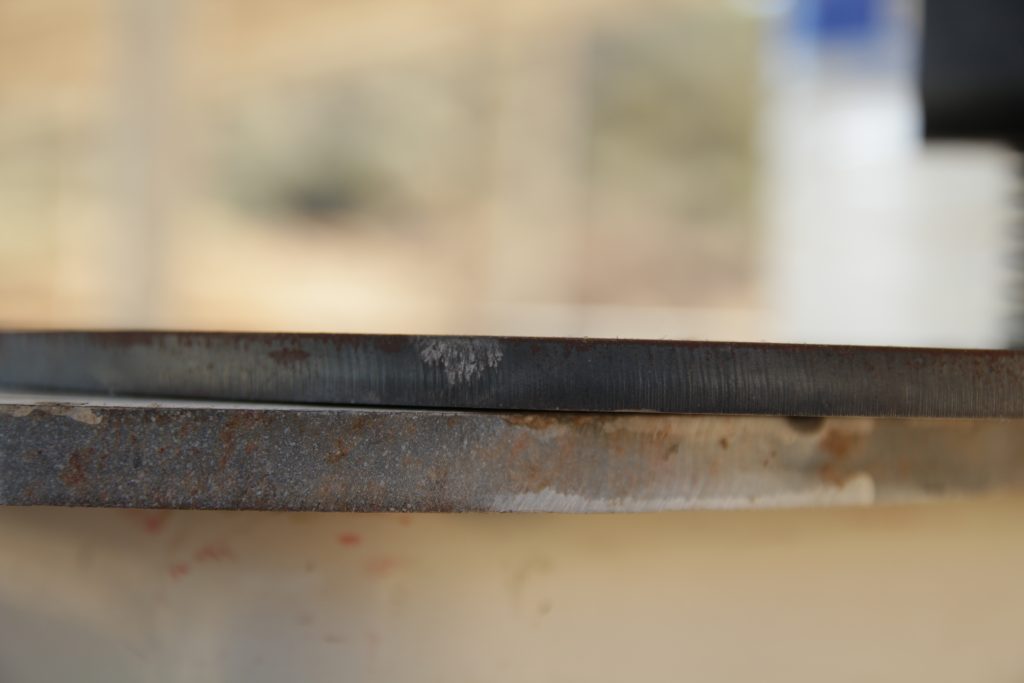
3/8″ AR500 on top, 1/2″ on bottom
- 0-700ft-lbs = ¼” AR500
- 700-2100ft-lbs = ⅜” AR500
- 2100-4000ft-lbs = ½” AR500
- 4000-10000ft-lbs = ⅝” AR500
You can calculate the energy of your projectile using a ballistic calculator as long as you know the weight of the projectile, the velocity, and the distance.
In general, you can cheat by simply moving a thinner target further away in order to use it with larger caliber rounds, but for getting a target at the 100 yard minimum recommended distance.
Reactive Targets
Reactive targets are the titties. Whether you’re shooting rifle or pistol targets, you’ll have a blast shooting something that moves, drops, or hides. Shooting steel targets is a great way to step up your training, or just spend more time shooting, and less time trekking out to swap out paper targets.
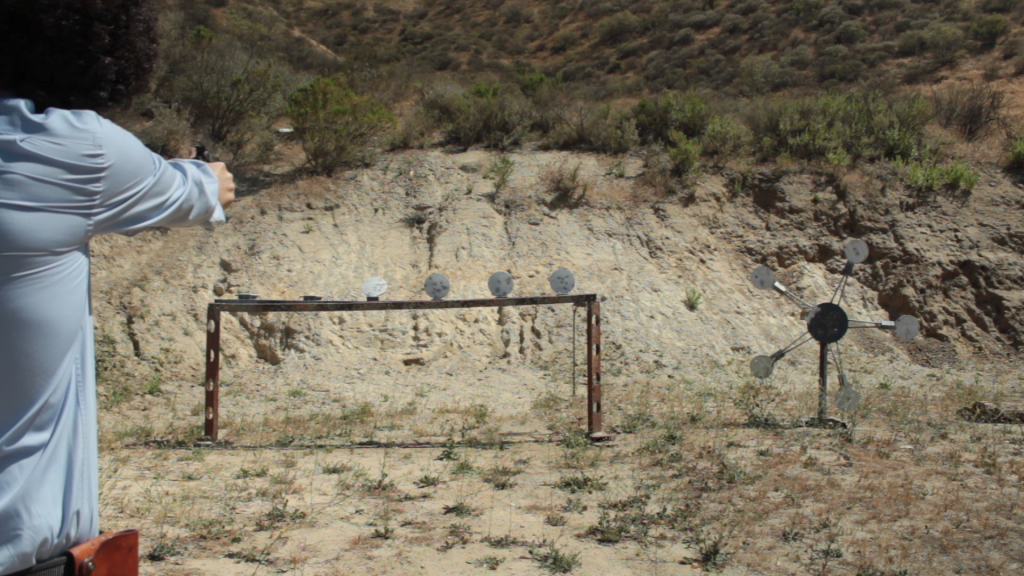
Bob Ross running a plate rack and Texas Star
Things like dueling trees, where you can actually have a little informal competition either with yourself or a partner, or a hostage swinger that presents a small target for fractions of a second before disappearing behind the “no shoot” portion of the target and popping out on the other side.
These targets help you practice shooting quickly, trigger control, and help build practical fundamentals.
Steel Target Stands
Whether you go with a reactive or static steel target, it’s important to have a proper stand.
You can make one out of sawhorses, metal pipe, all manner of things really, but it helps to have a proper stand, especially for dueling tree targets, rack plates, and other targets that really must have the appropriate stand to work properly.
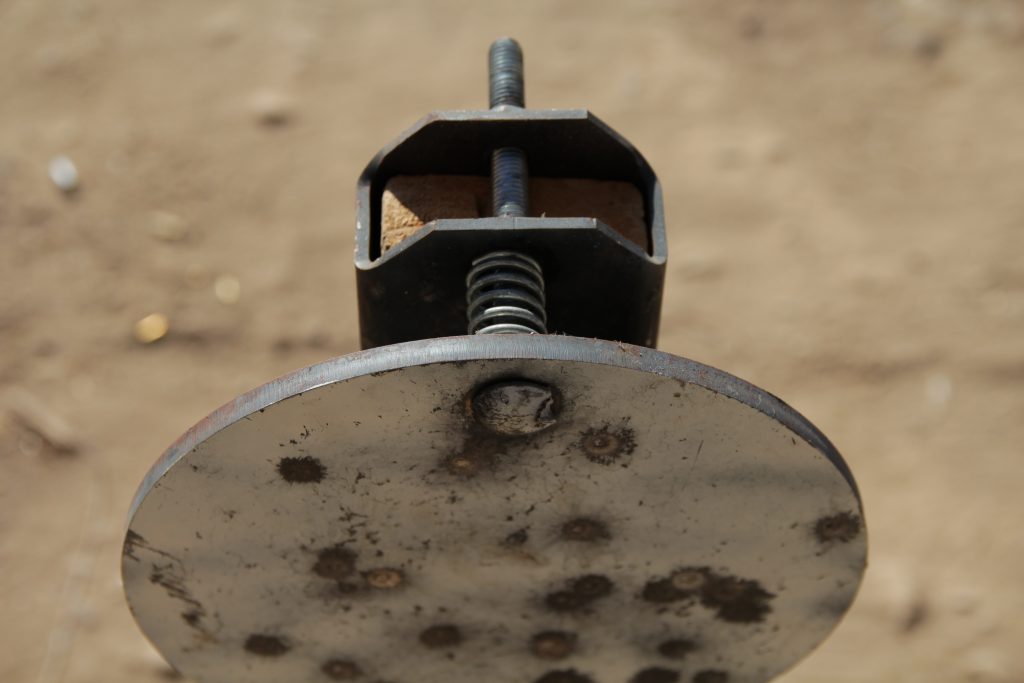
Stand designed to hang on 2x4s, spring loaded to absorb some of the impact
Also, the angle at which you shoot matters a great deal for preventing ricochets and controlling bullet fragmentation. The last thing you want is a fast-moving chunk of copper or lead streaking back towards where it came from. Always make sure your targets are at the manufacturer’s recommended angle from the firing line.
When hanging steel, like you would for a gong, pay attention to what you’re using to suspend the target. Chains get cut by rifle rounds, same with wire and rope. One thing that works great is conveyor belt material or any reinforced rubber. they can absorb a ton of rounds before they fail.
Steel Target Manufacturers
If all this has got you wanting to try out some steel targets for yourself, here are some manufacturers that are currently manufacturing targets:
Shoot Steel
Shoot Steel was founded by a shooter training for IDPA competitions. Founder Evan Moyer was unhappy with a lot of the target stands and options available, and so began to manufacture and sell his own.
Today, shoot steel offers stands, racks, lasercut reactive and static targets…everything you need to get started building a steel-centric range of your own.
Xsteel Targets
Xsteel targets is another company founded by shooters that were unhappy with steel target offerings…specifically, the high prices. Owners Bud and Will Sanson are avid shooters and hunters that have spent years developing a process that allows them to put out a wide variety of precisely-machined steel targets at affordable prices.
Side note: I bought the Classic IPSC targets, and the 10″ rounds from XSteel a few years ago. They didn’t list the Classic IPSC on their website at the time (I think they still don’t) but Bud was more than happy to cut a custom shape. The 2×4 hangers also came from them. They were so cool I’m leaving a link. http://www.xsteeltargets.com/
Shooting Targets 7
Shooting Targets 7 is a veteran-owned maker of a huge range of steel targets that provide great training options for anyone, but especially military, law-enforcement, and the defensively-minded civilian.
Action Target
Action Target specializes in the design, manufacture, and installation of targets, bullet traps, and other range necessities. If you’re building an indoor or outdoor range and want to get the very best, particular if your range will be a commercial venue or will see heavy use by military or law-enforcement, these are the folks to call.
MGM Target
MGM Target is similar to Action Target, but the range of services they offer is a bit broader. If you’re looking for rappel towers and other action-shooting or duty-focused accouterments for your range, or you just want some of the most advanced electronic and automatically-resetting targets around, give MGM careful consideration.
Wrap it up already!
Here are the cliff notes to that whole post:
- Steel Targets are fun
- Buy AR500 for anything over rimfire
- Buy the thickness needed for your intended round
- Don’t shoot it too close
- Don’t shoot cratered steel
- You need a stand
- Stop reading and go shoot!

